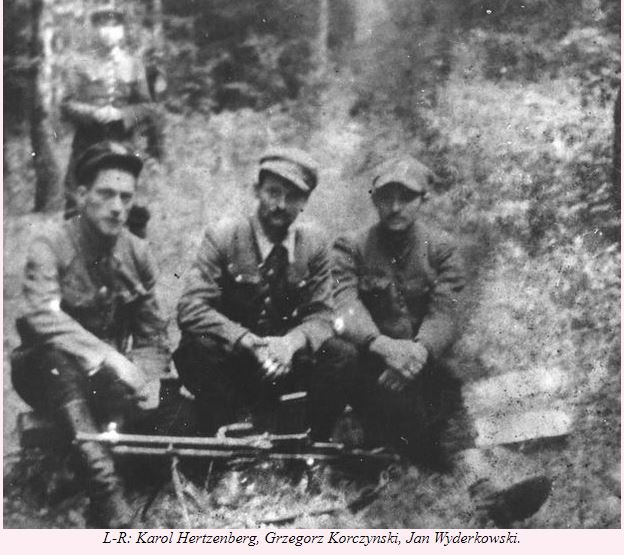Remembering the Victims of the Ludmilowka Pogrom
Ludmilowka is a tiny village to the west of Krasnik in Lublin district of eastern Poland. The current population is 530 people.
In the vicinity of Krasnik, Polish military Captain, Grzegorz Korczynski, appeared in the second half of August 1942 and immediately joined the existing Jewish partisan fighters in the area. Sent by the Armia Ludowa (AL) fighters, Korczynski quickly established his own squad of fighters. Among his close associates were Edward Gronczewski (called "przepiorka") and Jan Wzietek (called "murzyn"). One of their first actions was armed robbery at one of the nearby Polish estates. At this time, they were near the villages Ludmilowka and Grabowka, west of Krasnik.
Korczynski was sent to unify the Armia Ludowa fighters in the area. Many of the armed fighters in the area were of Jewish origin, hiding out from the Nazis in the vast forests of Janow Lubelski. For reasons that are still not clear other than being a vile anti-Semite and greedy person, Korczynski began murdering Jews in the Lublin district in 1942. His first Jewish victim was Jankiel Skrzyl (called "kaczor"), an escapee from the Janiszow Labor Camp, who he murdered with blows to his head. In the next few weeks, five more Jews (including another Janiszow escapee called Shlomo) were killed -- three men and two women [1]. Shortly after, Korczynski reported a group of about 30 fugitives from the camp for prisoners of war in the Lublin (Lipowa 7), all of Jewish origin. This group, which was led by the Jewish soldier David Reisler, was also murdered by Korczynski, in October 1942 [2].
Korczynski's actions had little military significance for the Armia Ludowa and resulted in reprisals and raids by the Germans, which reduced the chances of survival of the Jewish partisans in the area. In November, 1942, Korczynski's unit successfully aided a coordinated attack on the Janiszow Labor Camp. A German guard was killed and his valuables were taken. Around 30 to 40 young Jews were freed from the camp and were intended to be used as fighters with the Armia Ludowa.
But after returning to Ludmilowka, Korczynski demanded a ransom of 600 zlotys from the escaped Jewish prisoners who were now fighting as partisans, arguing that this amount was needed to purchase arms for the fighters.
Even more Jews were murdered by Korczynski. In Ludmilowka, Korczynski and Stefan Staregowski put forward a plan to to get rid of the remaining Jews as a "threat" and advanced this idea to members of the Armia Ludowa.
As the district leader for the Armia Ludowa, Korczynski had free reign in the Krasnik area. Having no supervision, he decided to attack a location in Grabowiec and murdered both Jews and non-Jews in doing so. He collected the valuables from all of the people he murdered. After this, Feliksy Wyganowski organized a meeting of the PPR committee, which displayed the clothes, personal belongings and valuables of murdered Jews. The Committee sentenced Korczynski to death for his actions.
Returning December 6 to Ludmilowka, Korczynski launched a bloody revenge. Trapped opponents were killed on the spot. Hiding Jews in the area were treated as supporting the opposition and as such also ruthlessly murdered. A Jewish woman named Perla Zurek was shot. Using firearms, grenades, and tools, another 100 Jews were murdered.
Under the pretext of crimes against the Jews during the German occupation, Korczynski was arrested on May 21, 1950 by Lt. Col. Jozef Swiatle. On May 22, 1954, Korczynski was sentenced to life imprisonment, converted by the Supreme Court on Dec. 24, 1954 to 15 years. Other collaborators also receive sentences, but none were higher than eight years of imprisonment. Korczynski was released in April, 1956 and then went to Warsaw.
The pogrom at Ludmilowka took place between November, 1942 and February, 1943. Numerous actions were taken against Jews in the area surrounding Krasnik, Poland and countless Jewish partisan fighters -- members of the Armia Ludowa -- were murdered by communist guerrillas of the People's Guard. The criminal motivations were robbery and a power struggle in the Polish Workers' Party. Most of the murder victims were women and children.
Additional Note: Andrzej Flis (1916-1981), partisan name Maksym, participated in the murders of the Jews of Ludmilowka in December, 1942 by a branch Korczynski partisans.
WORKS CITED
[1] Piotr Gontarczyk. Z genealogii elit PZPR. Przypadek Stefana Kilianowicza vel Grzegorza Korczynskiego. "Glaukopis". Nr 1, s. 214-229, 2003.
[2] Piotr Gontarczyk: Polska Partia Robotnicza: droga do wladzy (1941-1944). Warszawa: Fronda, 2006, s. 178-182. ISBN 83-60335-75-3.
ADDITIONAL SOURCES
Marek Jan Chodakiewicz, Piotr Gontarczyk, Leszek Zebrowski: Tajne oblicze GL-AL i PPR: dokumenty. T. 2. Warszawa: 'Burchard Edition', 1997, s. 61-64. ISBN 83-904446-7-4.
Rafa; Drabik. Watazkowie z Gwardii Ludowej. "Dodatek historyczny IPN". "Triumf komuny" (kopia), s. 7, 30.04-1.05.2009. "Rzeczpospolita".
Tomasz Labuszewski, Kazimierz Krajewski. Rzecz o dowolnosci dowodow zbrodni. "Biuletyn Instytutu Pamieci Narodowej". nr 3-4/2006, s. 95-102. IPN.
Bohdan Urbankowski: Czerwona msza, czyli Usmiech Stalina. T. 1. Warszawa: "Alfa-Wero", 1998, s. 352. ISBN 83-7001-971-4.
Pawel Wieczorkiewicz: Historia polityczna Polski 1935-1945. Warszawa: Ksiazka i Wiedza, 2005, s. 334. ISBN 83-051337-8-8.
Return to Lublin Index
